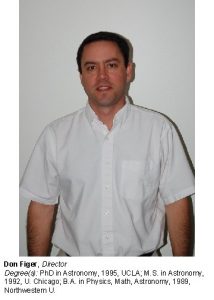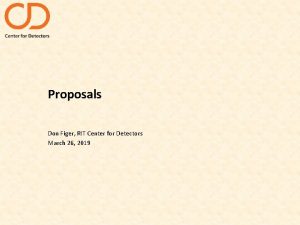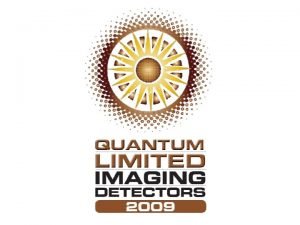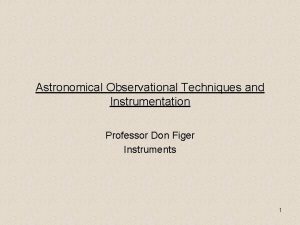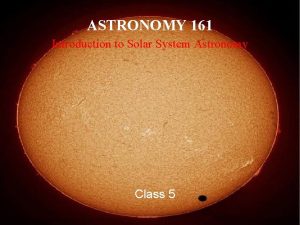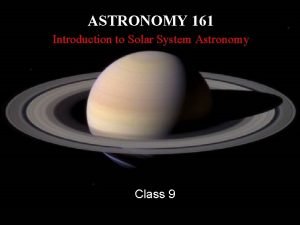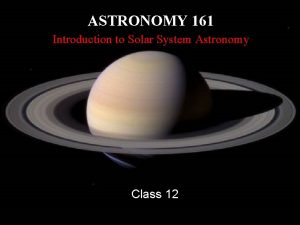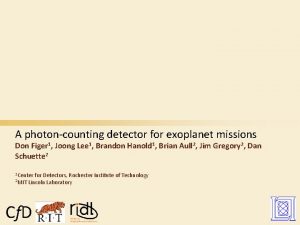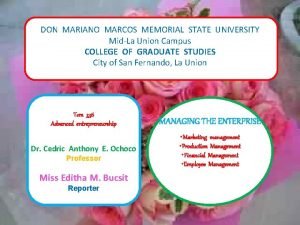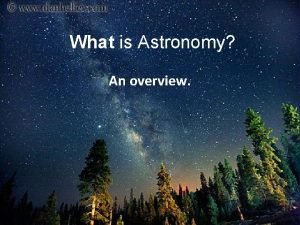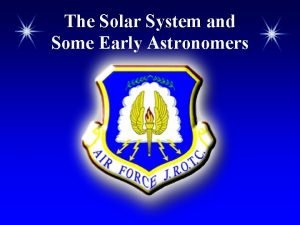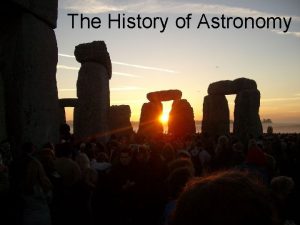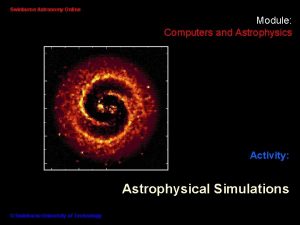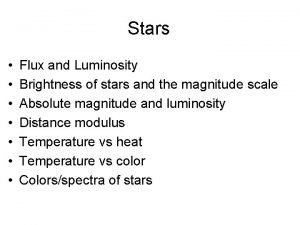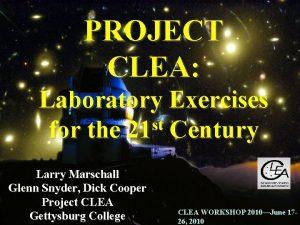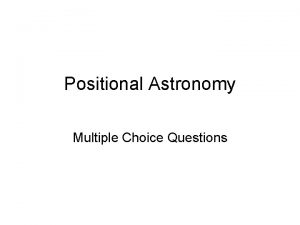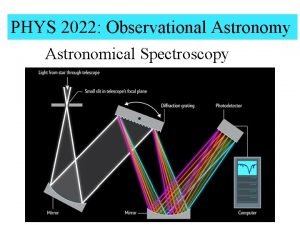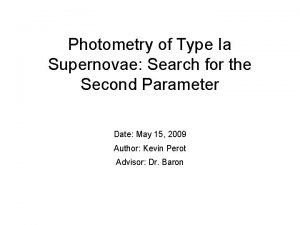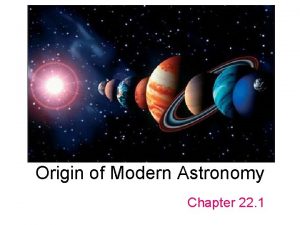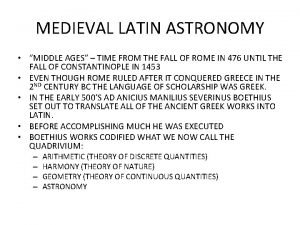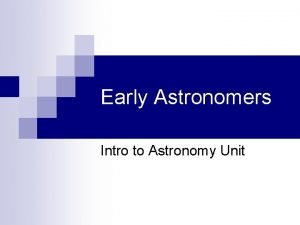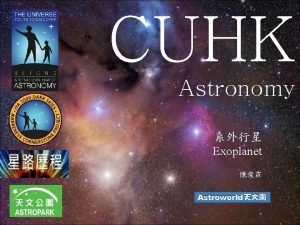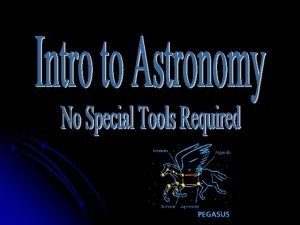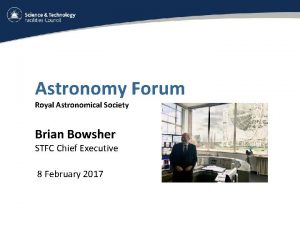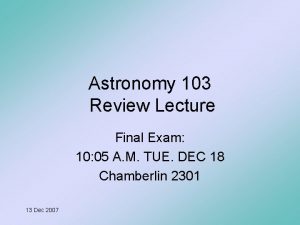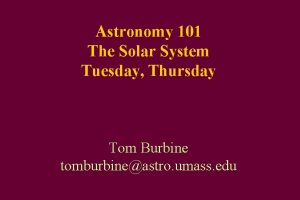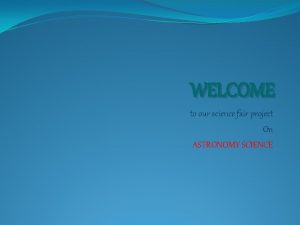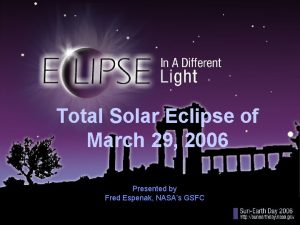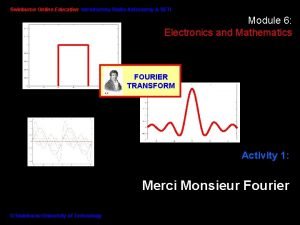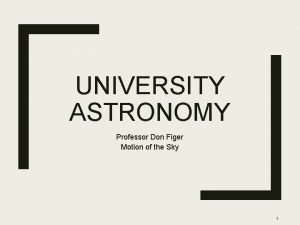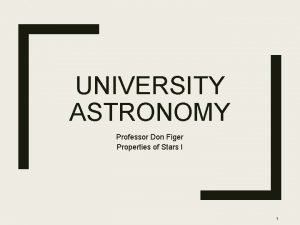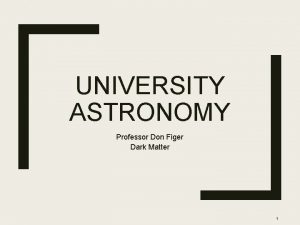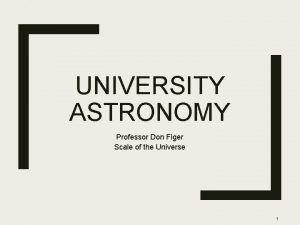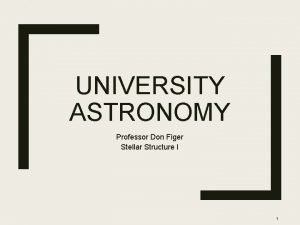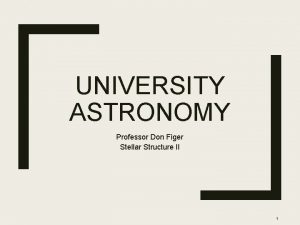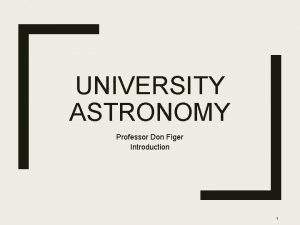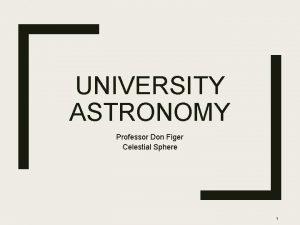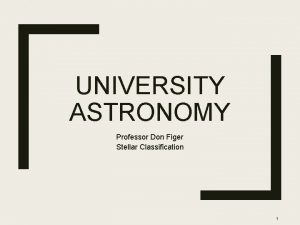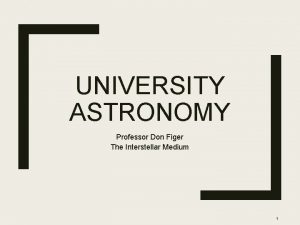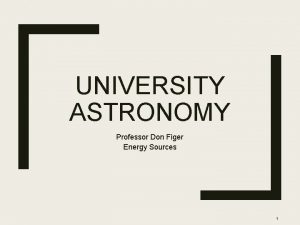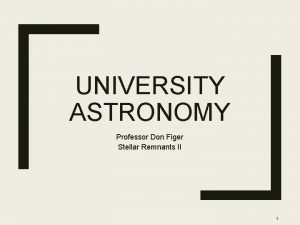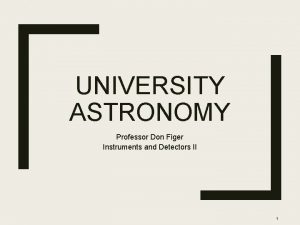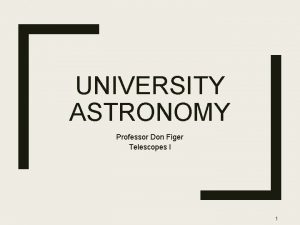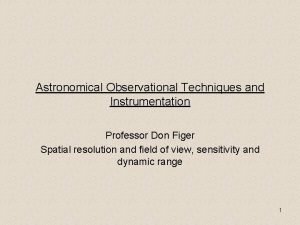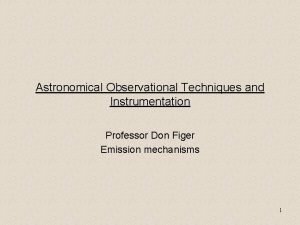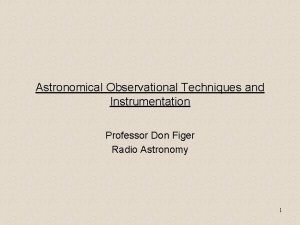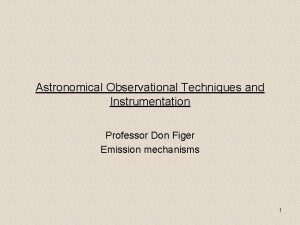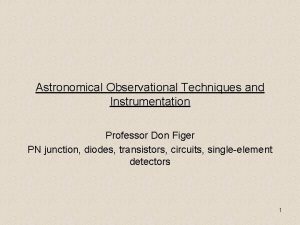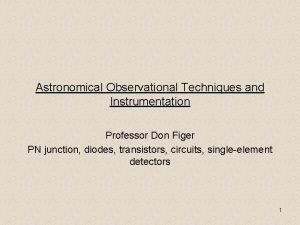UNIVERSITY ASTRONOMY Professor Don Figer Solar System I






































- Slides: 38

UNIVERSITY ASTRONOMY Professor Don Figer Solar System I 1

Aims and outline for this lecture ■ introduce the Solar System ■ review historical models for the Solar System ■ introduce orbital mechanics ■ review characteristics of planets 2

SOLAR SYSTEM SIZE 3

The Solar System ■ As its name implies, the Solar System is the collection of bodies that are gravitationally bound by the Sun. ■ Gravitationally bound means that objects don’t fly away. ■ The term is also sometimes used to designate a location, such as, when an interstellar object “passes through our Solar System. ” ■ It consists of the Sun, planets, asteroids, comets, dust, solar wind, etc. 4

Solar System Size Scales 5

Solar System Size Scales ■ Most visualizations of the Solar System are not to scale. ■ For instance, the picture on the following slide preserves the relationships between the sizes of the planets and Sun but not their distances. 6

Solar System Visualization 7

Watch this Video ■ Cool Video About the Scale of the Solar System ■ https: //www. youtube. com/watch? v=z. R 3 Igc 3 Rhfg 8

Solar System Geography 9

SOLAR SYSTEM MODELS 10

Motions ■ Objects in the Solar System orbit the Sun. ■ The orbits are nearly circular, roughly in the same plane, and are in the same direction. ■ Most planets rotate in the same direction of their orbital motion. ■ Moons are similar, yet orbit other bodies. 11

Historical Models ■ Ancient Greeks thought Earth was at the center of the Solar System (Ptolemy). 12

Copernican Model ■ Copernicus (1543) put the Sun at the center (heliocentric) of the Solar System (and the Universe!). ■ The model had several features that are different than the geocentric Ptolemaic model. – Planets orbit around Sun. – Earth rotates, revolves, and is on a tilted axis. – Retrograde is caused by Earth motion. 13

Keplerian Model ■ Kepler realized that orbits are elliptical (1 st law). ■ Planets sweep equal areas in equal time (2 nd law). ■ The square of the orbital period is proportional to the cube of the distance to the Sun (3 rd law). 14

Kepler’s 2 nd Law 15

Kepler’s 2 nd Law 16

Kepler’s 3 rd Law 17

Question ■ Asteroids are about 4 AU away from the Sun. What is their orbital period? – a) 4 years – b) 8 years – c) 16 years – d) 64 years 18

Answer ■ Asteroids are about 4 AU away from the Sun. What is their orbital period? – a) 4 years – b) 8 years – c) 16 years – d) 64 years ■ Distance cubed is 4*4*4=64. The square root of that number is 8. 19

Newton’s Laws ■ 1 st law: An object either remains at rest or continues to move at a constant velocity, unless acted upon by a force. ■ 2 nd law: The vector sum of the forces F on an object is equal to the mass m of that object multiplied by the acceleration a of the object: F = ma. ■ 3 rd law: When one body exerts a force on a second body, the second body simultaneously exerts a force equal in magnitude and opposite in direction on the first body. 20

Newton’s Law of Gravitation ■ Every point mass attracts every single other point mass by a force acting along the line intersecting both points. ■ The force is proportional to the product of the two masses and inversely proportional to the square of the distance between them. ■ G=6. 67(10 -11) m 3/kg/s 2 21

THE PLANETS 22

Rocky and Gas Planets ■ Rocky planets are like the Earth, and are thus sometimes called “terrestrial planets. ” They are small and close to the Sun. ■ Gas planets are like Jupiter, and are thus sometimes called “Jovian planets. ” They are large and far from the Sun. 23

24

Terrestrial Planet Interiors 25

Terrestrial Planet Layers ■ Interiors differentiated early in the planet’s history when the material was molten. ■ The highest density materials sank to the center. ■ Heat of formation dissipates more quickly for small objects, such as Mercury and the Moon. ■ Some heat is still leftover from formation, thus driving geological activity. 26

Jovian Planets ■ Jovian planets are big (~4 to 10 times size of Earth). ■ They are less dense than rocky planets, roughly density of water. ■ They are mostly gas (hydrogen and helium). ■ They have many moons. ■ Central pressures not high enough to fuse hydrogen, such that they are not stars. 27

JS vs. UN ■ JS are massive enough to have pressure sufficient to make metallic hydrogen. ■ N has internal heat that drives atmospheric contrasts, like JS. 28

Mercury ■ Mercury is made of metal and rock with an iron core. ■ It rotates three times every two years. ■ The surface toward the Sun is hot (430 C), the night side is cold (-170 C). ■ Poles are constantly cold (-100 C) because the axis is not tilted. ■ Mariner 10 (1974) and Messenger (2011) visited. 29

Venus ■ Venus is similar to size of Earth but covered by clouds. ■ It is hotter than Mercury and the heat is distributed. ■ The atmospheric pressure is very high. ■ It is volcanically active with little evidence of erosion. ■ Venera landed (1975) and Magellan mapped (1990). 30

Earth ■ Earth is where you are right now. ■ It has abundant water and abundant semiintelligent life. ■ The Moon is relatively large. ■ The Earth is round (not flat). 31

Mars ■ Mars has a thin atmosphere of CO 2. ■ It has dormant volcanoes, a large canyon, evidence of water in the past, and frozen water now. ■ It has no protection from UV light nor cosmic rays. ■ Many spacecraft visited, e. g. Viking (1976), Pathfinder, rovers, etc. ■ There is evidence of present-day water. 32

NASA In. Sight Mission ■ In. Sight (Interior Exploration using Seismic Investigations, Geodesy and Heat Transport) landed on Mars in late 2018. ■ It’s primary mission is to determine the interior structure of Mars using seismometers. 33

Jupiter ■ Jupiter is over a thousand times bigger in volume than the Earth, yet is only ~300 times more massive. ■ It has ~0. 001 the mass of the Sun, too little to become a star. ■ Its composition is similar to the Sun. ■ It has many moons (>70) and a faint ring. ■ It has a strong magnetic field, aurora, and lightning. ■ Its bands formed by winds. Spots are storms. ■ It has been visited by Voyager (1970 s), Galileo, and Juno. 34

Saturn ■ Saturn is similar to Jupiter, but with a huge ring system. ■ It has many moons (>62), including Titan that is covered in clouds. ■ Saturn’s rings are made of mostly chunks of water ice up to a few meters in size. ■ It was visited by Voyager and Cassini spacecraft. 35

Uranus ■ Uranus is an icy planet. ■ Its rotation axis is tilted nearly 90 degrees. ■ It is barely visible with naked eye. (Sir William Herschel first tracked it, thinking it was a comet – he earned a few hundred bucks from the King!). ■ It has a ring system (discovered on an airplane!). ■ Its moons orbit in the plane of the rings. 36

Neptune ■ Neptune is similar to Uranus. ■ It was discovered after a prediction by Alexis Bouvard based on the orbit of Uranus. (Galileo thought it was a star. ) ■ It has 14 moons, with Triton being the largest and which rotates retrograde. 37

Temperatures ■ 38
 Don figer
Don figer Heilmeier catechism
Heilmeier catechism Figer definition
Figer definition Pupil plane
Pupil plane Learning astronomy by doing astronomy activity 1 answers
Learning astronomy by doing astronomy activity 1 answers Learning astronomy by doing astronomy activity 7 answers
Learning astronomy by doing astronomy activity 7 answers Learning astronomy by doing astronomy activity 1 answers
Learning astronomy by doing astronomy activity 1 answers Astronomy 161
Astronomy 161 Solar system astronomy class
Solar system astronomy class Solar system astronomy class
Solar system astronomy class Figer counting
Figer counting Promotion from assistant to associate professor
Promotion from assistant to associate professor Michigan state university astronomy
Michigan state university astronomy Wholesale sun solar panels
Wholesale sun solar panels Inexhaustible source of energy
Inexhaustible source of energy Taking something that doesn't belong to you
Taking something that doesn't belong to you Don mariano marcos memorial state university
Don mariano marcos memorial state university Branches of astronomy
Branches of astronomy Claudius ptolemy astronomy contributions
Claudius ptolemy astronomy contributions Astronomy greek roots
Astronomy greek roots Swinburne astronomy online
Swinburne astronomy online Astronomy
Astronomy Magnitude of flux
Magnitude of flux Vireo clea
Vireo clea Astronomy questions and answers multiple choice
Astronomy questions and answers multiple choice Phys2022
Phys2022 Distance ladder astronomy
Distance ladder astronomy Origin of modern astronomy chapter 22
Origin of modern astronomy chapter 22 Astronomy in the middle ages
Astronomy in the middle ages Geology earth science definition
Geology earth science definition Claudius ptolemy astronomy contributions
Claudius ptolemy astronomy contributions Cuhk astronomy
Cuhk astronomy Astrologist vs astronomer
Astrologist vs astronomer Astronomy forum uk
Astronomy forum uk Astronomy 103 final exam
Astronomy 103 final exam Astronomy 101 formulas
Astronomy 101 formulas Astronomy science fair projects
Astronomy science fair projects Astronomy picture of the day march 29 2006
Astronomy picture of the day march 29 2006 Time domain astronomy
Time domain astronomy
